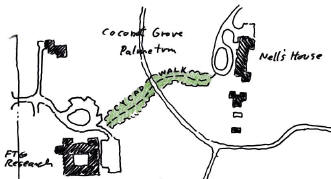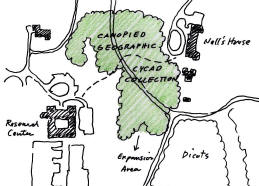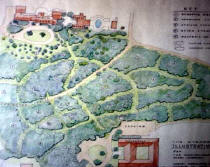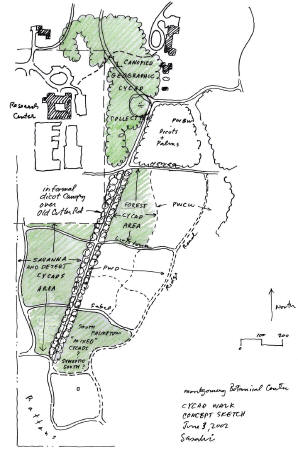The Cycad Walk
The Cycad Walk is a habitat-based collection of cycads, estimated to ultimately contain approximately 5,000 cycads when completed.
In 1992, Joe Hibbard of the internationally recognized landscape architectural firm of Sasaki Associates, Inc., created a long-term Master Site Plan for MBC. The Plan defined long-term land use, access and circulation, and landscape structure. A major landscape project within the Master Site Plan was the upgrading and expansion of the “ Cycad Walk,” which was originally conceived and developed in the 1970s as a small, east-to-west walking path lined with a few cycads.


The 1995 Cycad Walk design is based on the original geographical source of the population samples. Within the six acres, the design plan includes multiple beds from each cycad region of the world. The 1995 concept of the Cycad Walk was completed in 2003 and now consists of 15 Asia beds, 2 Africa beds, 6 America beds, and 3 Australia beds. Shortly thereafter, the area was re-named the Cycad Geographic Collection.
The 1995 design plan by Sasaki Associates for MBC’s Cycad Walk. At the top is Nell’s House, where the Cycad Walk begins.

In 2001, due in part to the success of the numerous international expeditions MBC has undertaken, contributions from individuals and other institutions throughout the world, and the large number of new cycad populations and taxa being discovered and described, Sasaki Associates critically evaluated the 1995 Cycad Walk design with respect to available planting space. Based on their evaluation, the Cycad Walk area was doubled to include over 13 acres of the 120-acre property.
We estimate the area will ultimately contain approximately 5,000 cycads when completed. Instead of moving east-to-west, the main path of the Cycad Walk now runs north-to-south to take advantage of the full length of the property. This new addition to the Cycad Walk has been named the Cycad Ecologic Collection.

The planting design within Cycad Ecologic Collection will take a different approach than the geographically-oriented concept for the original Cycad Geographic Collection. Instead of arranging plants by their region of origin, plants will be arranged based on their respective habitat preferences.
The current plan includes a 4.5-acre Cycad Savannah area, which will house cycad species that grow in desert and savannah habitats in Africa, Australia, India, and Mexico. The 1.5-acre Oak Woodland area will consist of primarily cycads of the genus Dioon, as well as other New World species that typically grow within tropical oak forests. Finally, the 1-acre Tropical Forest area will be heavily wooded, will include an extensive below-grade grotto, and will be the future home of tropical rainforest cycad species.
Montgomery Botanical Center Cycad Savannah Soil/Drainage Testing Project (PDF)
Somewhere in the complex evolutionary pattern between the ferns and seed-plants came the cycads, which are tropical and relatives of other cone-bearing plants.
